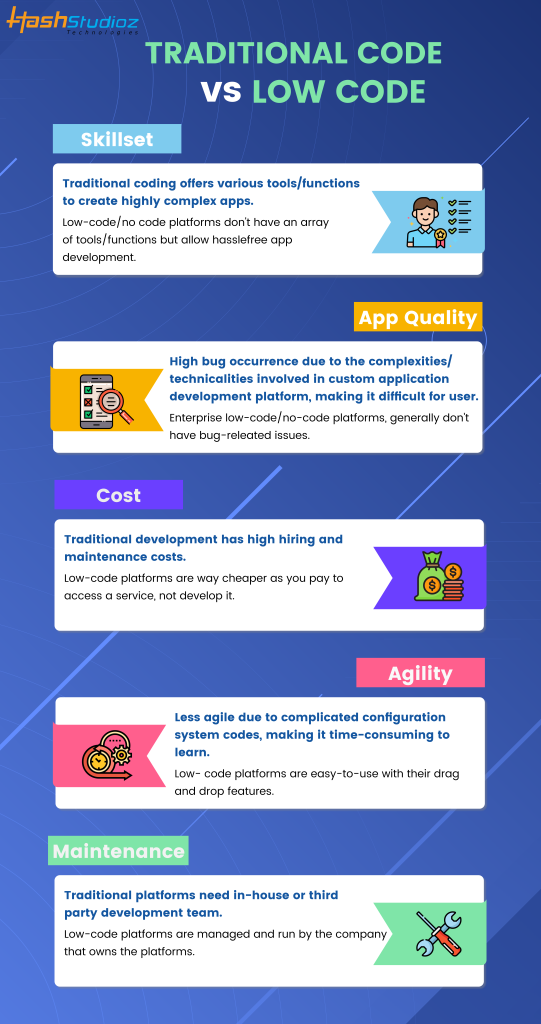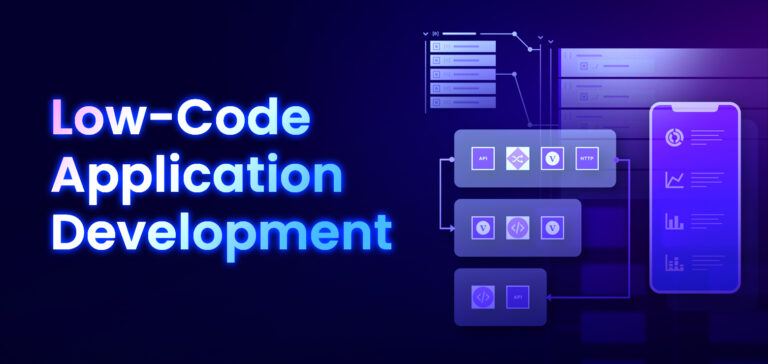Handy Reasons On Deciding On application development with Low-code platforms
In Regards To Integration Capabilities Low-Code Applications Development Has Many Advantages.Low-code applications offer significant advantages when it comes to integration capabilities, which are crucial for building applications that can seamlessly integrate with diverse systems and services. Here are a few main benefits: pre-built connectors and APIs.
Many Connectors to Choose From Low-code platforms usually have a large library of connectors that are pre-built for popular enterprise software (e.g., ERP, CRM, databases, cloud services). The process of integrating these systems is made simpler.
API Integration: Many Low-Code platforms have out-of-box API integration tools that allow developers to quickly connect external services and data resources.
Simple to use:
Integrations with Drag-and-Drop: Integrations can be implemented with drag and drop interfaces. Developers and non-developers can accomplish this without having to write lengthy code.
Visual Workflow Builders : Tools for creating workflows and data flow which are visually represented help to learn and configure integrations in a much more simple method.
Standardized Integration Methods:
SOAP/RESTful Services Support: Standard web services protocols, like SOAP/REST, facilitate the integration of a range of different systems and applications.
OData and Other Standards: Support for standards like OData enables easy access and manipulation of data on a variety of platforms and software.
Real-Time Data Synchronization:
Real-Time Integrations: Low-code platforms can handle real-time data sync between applications and systems. This makes sure that the information is current and synchronized across the company.
Event-Driven Architecture: Certain platforms can support event-driven architectures. permitting applications to respond to events in real-time, which is crucial for interactive and dynamic applications.
Legacy System Integration:
Low-code platforms offer a variety of tools for integrating with legacy systems. They allow organizations to modernize IT without re-designing their current systems.
Data Migration: Built-in tools help transfer data from older applications to new ones that are built on platforms that have low-code.
Integration of third-party services:
Cloud Services: Integration with cloud services such as AWS Azure and Google Cloud allows easy deployment and scaling.
Business Application Integration: Low-code platforms have the ability to integrate with different business applications like Salesforce, SAP, Microsoft Dynamics, etc. to create a seamless workflow that spans different business processes.
Simplified Data Processing
Unified Data Models - Some low-code platforms provide unification of data models which make it easier to manage data and integration with other systems.
Data Connectors - Connectors pre-configured to permit simple access to, as well as manipulation of data from diverse sources.
Security and Compliance
Secure Integrations: Low code platforms guarantee that integrations adhere to security protocols and standard safeguarding data while in transportation as well as during rest.
Security Features: These platforms typically have features that ensure that the integrations meet regulatory requirements, such as GDPR or HIPAA. This provides peace ofmind for businesses handling sensitive data.
Extensibility:
Custom Code and Scripts: Low-code platforms are often able to handle more complicated integrations, allowing for the addition of custom scripts and codes. This allows for flexibility without compromising on ease of usage.
Plug-in Ecosystems: A plugin ecosystem can be utilized to enhance the integration capability and allows users to add additional functionalities as needed.
All in all low-code development platforms have robust integration capabilities that make them an ideal tool for building interconnected and efficient applications. They make it easier for connecting disparate systems, improve the flow of data, and allow enterprises to use existing technology while embracing new ones, which results in the integration of a seamless IT environment. Take a look at the recommended more help about Low-code Platform for application development for blog info including rapid applications, rad development, cross platform app development, sso azure, rapid action development, app modernisation, develop web application, low code development platforms, app development platform, push notifications and more.

The Benefits Of Developing Low-Code In The Areas Of Governance And Security
Low-code development can bring many advantages regarding security and governance. These are crucial to ensure that applications are secure, compliant and well-managed throughout their entire lifecycle. Here are a few of the most important advantages:
Unified Management Console (UMC): Low-code platforms often offer a central management console, where administrators are able to supervise and manage all applications to ensure a uniform governance throughout the entire organization.
Role-Based Access Control RBAC : These platforms usually include robust roles-based access controls, which enable administrators to create and enforce rules. Only authorized users are able to access and modify specific areas of an application.
Compliance and Regulatory Applicability:
Many low code platforms include built-in compliance features. These are built to ensure that apps comply with industry standard (e.g. GDPR, HIPAA). They provide frameworks and tools to help ensure that applications meet these requirements.
Audit Trails and Logging: Audit trails and logs that are comprehensive can be incorporated to allow companies to monitor changes, monitor access and ensure the compliance.
Increased Security Measures
Data Encryption. Low code platforms typically provide encrypted data built-in, both in transit and when at rest. This protects sensitive information.
Security Certifications - A lot of lowcode providers hold security certificates, like ISO 27001 (or SOC2), which demonstrate the adherence to high security standards. Users can be assured that these companies adhere to the standards.
Automated security updates:
Regular Patching and Updates: Lowcode platforms usually provide regular updates to security. These patches safeguard software from the latest threats without requiring developer intervention.
Security Monitoring Tools: These tools send alerts that are updated in real time, and provide insights into security concerns that might be present.
Data Governance
Data Access Policies These systems enable organisations to create data access policies and then enforce them, ensuring data is only available to those who have been granted access. They also make sure that the data is being used in a safe manner.
Data Masking Anonymization: Built-in data masking tools and anonymization features help protect sensitive information, particularly in the development and testing phases.
Consistent Application lifecycle Management
Development and Deployment Pipelines Low-code platforms usually offer integrated deployment and development pipelines that incorporate security checks to ensure that security remains intact throughout the application lifecycle.
Version Control. Integrated version management helps to track and reverse any changes made to the application, while ensuring that its integrity is preserved.
Authorization, User Authentication and Authorization
Single Sign-On (SSO) Single sign-on support as well as other advanced authentication methods simplify management of users and improves security.
Multi-Factor Authentication A number of platforms come with integrated functionality to verify multi-factor identities that adds an extra layer for security.
Policy Enforcement Monitoring and Compliance:
Policy Templates: Low-code platforms often include pre-defined templates for security and governance that allow organizations to quickly apply policies.
Tools for Monitoring Compliance: These tools are able to monitor and report continuously on the status of compliance. They make it easier to spot issues and tackle them in a proactive manner.
Integration with Existing Security Infrastructure:
Seamless Integration: Low-code platforms are designed to work with current security tools and infrastructure, such as identity management systems and SIEM (Security Information and Event Management) solutions, and firewalls.
API Security: API security features to protect data and ensure the integrity of the application are integrated into the API.
Training and Best Practices
Good practices: Several platforms have guidelines for creating secure applications and provide the best practices. This helps non-developers to comply with security standards.
Some lowcode providers provide tools and security education for users to understand how to build and maintain a secure application.
Overall, the governance and security advantages of developing applications using low-code ensure that applications are built and managed in a secure as well as compliant method. These platforms include the tools and frameworks needed to oversee and manage process of developing applications, and protect sensitive data while maintaining the compliance of regulations and enforcing rules. Check out the top continue reading this for Legacy application modernization with Low-code for blog tips including app platforms, jdbc server, low code platforms, develop mobile application, low code platforms, jdbc server, paas service, push alerts, rad application development, cross platform app dev and more.

The Benefits Of Low-Code Development For Workflow And Collaboration
It's a great option for businesses that want to boost team productivity as well as streamline processes and enhance collaboration. These are the main advantages: Improved Cross-Functional Collaboration:
Unified Development Environment: Low-code platforms offer a unified, single environment where all team members, including business analysts, developers, designers, and other stakeholders can work effectively. This eliminates silos and promotes better communication.
Visual Development Tools: Low-code platforms are easy to use, and come with an interface that allows drag-and-drop. This lets non-technical people on the team to participate in the process of development, which ensures that business requirements can be captured precisely.
Improved Communication
Real-Time Collaboration: A lot of low-code platforms have real-time collaboration capabilities, such as simultaneous editing, commenting, and instant feedback, which enable continuous communication and cut down on the time wasted in back-andforth conversations.
Shared workspaces: Teams are able to work in tandem on shared workspaces where they can edit and discuss the project's elements. This will ensure that everyone is striving for the same objectives and are on the same page.
Workflow management simplified:
Project management tools that are built-in Low-code platforms are often equipped with project management tools integrated that let teams plan, track and manage their projects. This includes task assignments as well as progress tracking and deadline management.
Automating routine workflows and activities reduces mistakes and manual labor that allows individuals and teams to focus on more strategic projects and increase efficiency.
Faster iteration cycles:
Rapid Prototyping: Low-code platforms allow rapid prototyping and iterative development that allow teams to design, test, and refine applications over shorter periods of time. This ensures that feedback can be quickly incorporated and improvements made rapidly.
Support for Agile Methodologies Supporting agile practices gives teams the ability to work in sprints and continuously provide small amounts of functionalities, making it easier to adapt to the changing demands.
Accessibility to non-developers
Citizen Development - Low-code platforms give business users the ability to create and modify apps without coding expertise. This helps to reduce the burden on IT and development teams and lets them respond faster to business demands.
Training and Onboarding. The intuitive interfaces of the tools for training allow new members to be familiar with the system and this helps improve the teamwork.
Centralized documentation and sharing of knowledge
Documentation integrated Platform features that are low-code usually allow you to create and manage documents on the platform. The entire project's information will be centralized and easily accessible.
Knowledge Repositories. Teams can set up repositories for knowledge, including templates and reusable parts. This will facilitate sharing of knowledge and will reduce duplication.
Consistency and Standardization
Standardized Components. Standardization of components across various applications assures uniformity, which helps to make it simpler to work with and be understood by team members.
Governance and Compliance: Built-in governance frameworks ensure that all development is in line with the organizational guidelines and regulations, reducing the possibility of non-compliance as well as ensuring that applications meet the quality standards.
Feedback and Improvement Loops
Integrated Feedback mechanisms: Low-code platform often have integrated feedback mechanisms that allow users to provide feedback on the application. Feedback can then become integrated into the development.
Continuous Improvement: The capability to quickly test and deploy changes based upon feedback ensures that applications are constantly enhanced, and are in line with the needs and objectives of users.
Visualization of Reporting:
Real-Time Analysis: Analytics and reporting tools integrated into the software give real-time insights on project progress along with user interaction and overall performance. This allows for data-driven decision making.
Visual Workflow Mapping - Visual tools that visualize workflows and processes can help teams optimize their workflows by identifying bottlenecks.
The main benefits of developing low-code applications in terms of workflow and collaboration lie in its capacity to connect diverse teams, streamline communication, and also automate processes. This fosters a team-oriented environment with an agile and efficient process for development, which results in higher-quality apps and a more effective alignment between the business goals.
